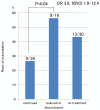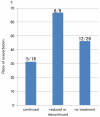Importance of appropriate pharmaceutical management in pregnant women with ulcerative colitis
- PMID: 23706098
- PMCID: PMC3680032
- DOI: 10.1186/1756-0500-6-210
Importance of appropriate pharmaceutical management in pregnant women with ulcerative colitis
Abstract
Background: Ulcerative colitis (UC) often occurs in women of childbearing age. Compared to Western countries, however, few studies have investigated the impact of UC on the progress of pregnancy in Asian populations.
Methods: We retrospectively examined 91 pregnancies in 64 patients with UC experienced at our hospital and related institutions from 1991 to 2011, focusing on the relationship between the progression of UC during pregnancy, progress of the pregnancy itself, and the treatment of UC.
Results: In 80 of 91 pregnancies the patient had already been diagnosed with UC at the time she became pregnant, of whom 31 (38.8%) experienced exacerbation during pregnancy. Regarding severity, moderate or severe active-stage disease during pregnancy was seen in 13.7% of those who had been in remission at the onset of pregnancy versus 58.6% of those who had been in the active stage at onset (OR 8.9: 95%CI 3.0~26.4; P<0.01). The incidence of miscarriage or abortion was 9.8% in pregnancies in which UC was in remission at onset versus 31% in those in which it was in the active stage at onset (OR 4.1: 95%CI 1.2~13.9; P=0.02). Among patients, 62.5% were receiving pharmaceutical treatment at onset of pregnancy. Exacerbation during pregnancy occurred in 26.5% of the group who continued to receive the same treatment during pregnancy versus 56.3% of those with a dose decrease or discontinuation after onset (OR 3.6: 95%CI 1.0~12.4; P=0.04).
Conclusions: UC patients wishing to conceive should do so when in remission and continue appropriate pharmaceutical treatment during pregnancy.
Figures




Similar articles
-
Long-Term Disease Course and Pregnancy Outcomes in Women with Inflammatory Bowel Disease: An Indian Cohort Study.Dig Dis Sci. 2017 Aug;62(8):2054-2062. doi: 10.1007/s10620-016-4353-5. Epub 2016 Oct 26. Dig Dis Sci. 2017. PMID: 27785711
-
Relationship between the Clinical Course of Ulcerative Colitis during Pregnancy and the Outcomes of Pregnancy: A Retrospective Evaluation.Intern Med. 2018 Jan 15;57(2):159-164. doi: 10.2169/internalmedicine.8550-16. Epub 2017 Oct 16. Intern Med. 2018. PMID: 29033411 Free PMC article.
-
[Ulcerative colitis and pregnancy].Nihon Shokakibyo Gakkai Zasshi. 1991 Jun;88(6):1313-8. Nihon Shokakibyo Gakkai Zasshi. 1991. PMID: 1890756 Japanese.
-
[Ulcerative colitis and pregnancy].Nihon Rinsho. 1999 Nov;57(11):2603-7. Nihon Rinsho. 1999. PMID: 10572439 Review. Japanese.
-
A review of infliximab use in ulcerative colitis.Clin Ther. 2008 Feb;30(2):223-30. doi: 10.1016/j.clinthera.2008.02.014. Clin Ther. 2008. PMID: 18343261 Review.
Cited by
-
A Novel Decision Aid Improves Quality of Reproductive Decision-Making and Pregnancy Knowledge for Women with Inflammatory Bowel Disease.Dig Dis Sci. 2022 Sep;67(9):4303-4314. doi: 10.1007/s10620-022-07494-9. Epub 2022 Apr 30. Dig Dis Sci. 2022. PMID: 35499712 Free PMC article.
-
Evidence-based clinical practice guidelines for inflammatory bowel disease.J Gastroenterol. 2018 Mar;53(3):305-353. doi: 10.1007/s00535-018-1439-1. Epub 2018 Feb 10. J Gastroenterol. 2018. PMID: 29429045 Free PMC article.
-
Evidence-based clinical practice guidelines for inflammatory bowel disease 2020.J Gastroenterol. 2021 Jun;56(6):489-526. doi: 10.1007/s00535-021-01784-1. Epub 2021 Apr 22. J Gastroenterol. 2021. PMID: 33885977 Free PMC article. Review.
-
Anti-TNF and thiopurine therapy in pregnant IBD patients does not significantly alter a panel of B-cell and T-cell subsets in 1-year-old infants.Clin Transl Gastroenterol. 2018 Apr 3;9(4):143. doi: 10.1038/s41424-018-0018-3. Clin Transl Gastroenterol. 2018. PMID: 29618720 Free PMC article.
-
IBD in pregnancy: recent advances, practical management.Frontline Gastroenterol. 2020 May 19;12(3):214-224. doi: 10.1136/flgastro-2019-101371. eCollection 2021. Frontline Gastroenterol. 2020. PMID: 33912333 Free PMC article. Review.
References
-
- Morita N, Toki S, Hirohashi T, Minoda T, Ogawa K, Kono S, Tamakoshi A, Ohno Y, Sawada T, Muto T. Incidence and prevalence of inflammatory bowel disease in Japan: nationwide epidemiological survey during the year 1991. J Gastroenterol. 1995;30(Suppl 8):1–4. - PubMed
-
- Fujimoto T, Kato J, Nasu J, Kuriyama M, Okada H, Yamamoto H, Mizuno M, Shiratori Y. Japan West Ulcerative Colitis (JWUC) Study Group. Change of clinical characteristics of ulcerative colitis in Japan: analysis of 844 hospital-based patients from 1981 to 2000. Eur J Gastroenterol Hepatol. 2007;19:229–235. doi: 10.1097/MEG.0b013e3280110fb9. - DOI - PubMed
-
- Yang SK, Yun S, Kim JH, Park JY, Kim HY, Kim YH, Chang DK, Kim JS, Song IS, Park JB, Park ER, Kim KJ, Moon G, Yang SH. Epidemiology of inflammatory bowel disease in the Songpa-Kangdong District, Seoul, Korea, 1985–2005: a KASID Study. Inflamm Bowel Dis. 2008;14:542–549. doi: 10.1002/ibd.20310. - DOI - PubMed
-
- Jiang L, Xia B, Li J, Ye M, Yan W, Deng C, Ding Y, Luo H, Hou W, Zhao Q, Liu N, Ren H, Hou X, Xu H. Retrospective survey of 452 patients with inflammatory bowel disease in Wuhan city, central China. Inflamm Bowel Dis. 2006;12:212–217. doi: 10.1097/01.MIB.0000201098.26450.ae. - DOI - PubMed
MeSH terms
Substances
LinkOut - more resources
Full Text Sources
Other Literature Sources
Medical

